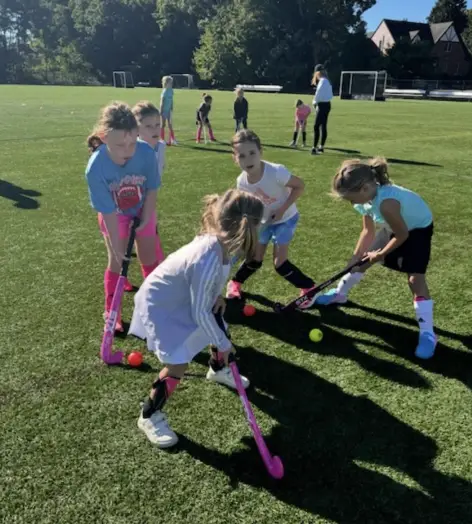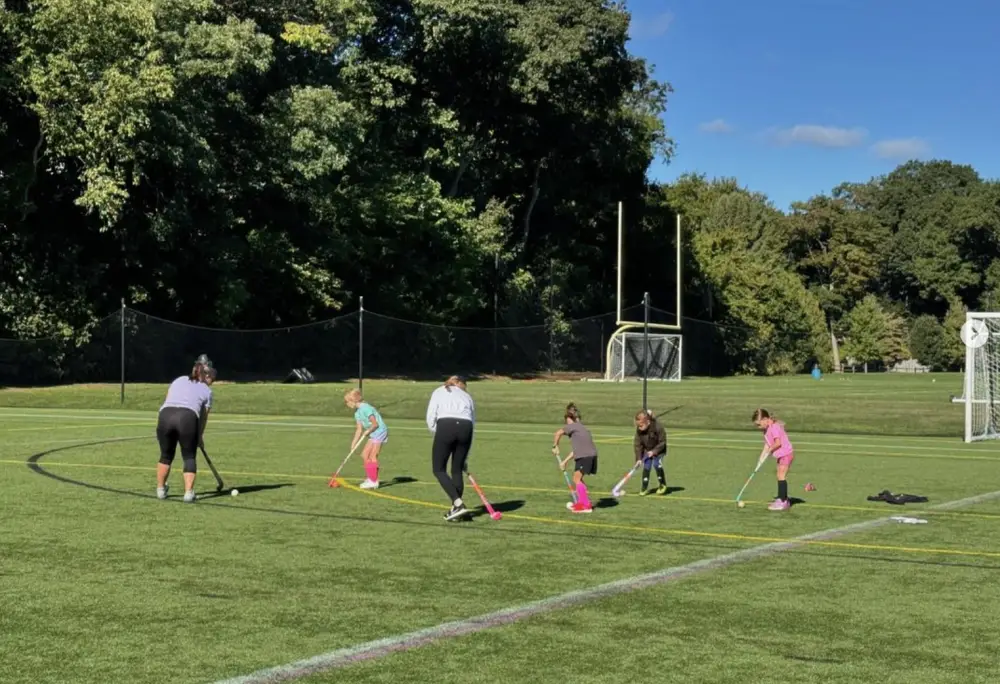Wellesley Youth Field Hockey Club celebrates turning 10
When the Wellesley High School field hockey team plays its first game under the new Hunnewell Field lights on Wednesday, Sept. 18, the crowd will be filled with family, friends, and lots of young players for “Youth Day.”
The town has built a strong field hockey community, thanks in large part to the Wellesley Youth Field Hockey Club, which turns 10 this year. The program, originally called Wellesley Scoops Field Hockey, has not only turned kids onto the sport early on, but has produced skilled players that go on to high school and college teams.
I connected earlier this month with Kelly Uller and Elizabeth Kaplan, both Wellesley Youth Field Hockey Club board members and moms of current high school players. None of the club’s four board members have kids in the program anymore, but they all remain dedicated to it. Board member Michael Bessette has led the junior umpire program and advocated for more boys to play, while Angela Snyder has been instrumental on the skills development and coaching program.

The club started in 2014 with about 40 first and second graders (now in high school classes of ’25 and ’26), and currently has more than seven times that number of participants in grades 1-8. The club seeks to field two teams per age group to ensure players are able to get quality coaching time and learn necessary skills.
Programs are offered during all four seasons, and include a mix of league play and skills training. Spring has become a particularly popular season for players who might have other activities during the fall; plus, there’s no travel required outside of Wellesley. Spring play goes all afternoon on Saturdays until the sun sets.
“Over the past few years we’ve really seen more players dedicating themselves to field hockey, not just kids who are like ‘Sure, I’ll try that.’ These players want and need real practice time and space,” said Kaplan, who played field hockey in college. With more kids in the program learning the sport early on, the results can also be seen at the high school level, with the Raiders experiencing more success in recent years (and off to a strong start in 2024).
Uller, a member of the town’s Playing Fields Task Force representing girls lacrosse, says the Youth Field Hockey Club has sought to rightsize itself for the available turf fields. No new turf fields are in the works, and that’s unlikely to change anytime soon, she said. In part this is because of community sentiment against putting artificial surfaces into natural environments (not that there aren’t some environmental benefits to turf fields, such as not needing to water them).
During the COVID-19 pandemic field hockey actually gained some turf field use because football got pushed to winter, and other sports moved as well. “We just didn’t give it up,” Uller said.
While field hockey really needs to be played on turf, other sports like lacrosse (especially at younger ages) and soccer don’t need to be, Uller and Kaplan said.
“It’s frustrating when you watch field hockey on grass at any level, especially for the little girls… the ball just doesn’t move,” Uller said. When the players get older, it gets dangerous on grass because they tend to chop at the balls and send them flying, she said. (As an aside, Dana Hall School has a great grass field, but that’s because it’s mowed very low.)
While more players are starting to specialize in field hockey, Wellesley Youth Field Hockey Club aims to keep its practice and game schedules from conflicting with those of other youth sports such as lacrosse and soccer. Uller and Kaplan said they still believe that kids, especially younger ones, should be exposed to multiple sports.
They said they’re proud though when players move on from the town program to other higher-level field hockey clubs as they get through middle school. “It means that we’ve done our job,” Uller said.
The town program features instructors who really know the game, but relies mainly on parent coaches who may be less familiar with it. “It can be intimidating for parents,” Kaplan acknowledges, but assures that they don’t need to be experts, especially when coaching younger kids. The focus is on keeping things fun for players as they learn the game.
One reason the program has gained participants is that the sport has become more visible. When the club started, it spent much of its time on Wellesley College fields, which while nice, weren’t really in the public eye. Since shifting games and practices to the Sprague Fields, more kids and parents have had a chance to notice field hockey and get intrigued by it.
Uller says she recalls walking across the Sprague Fields one day and hearing a kid ask her mom what the girls were playing, and the mom said “I think it’s lacrosse.” Hopefully between field hockey becoming a more common sight in town (and maybe even getting some exposure during the summer Olympics), the game is becoming more familiar to more people in town.
Having a couple of night games on the Wellesley High field hockey team’s schedule will only help increase exposure, Uller said. A lot of the good high school programs have lights, and the Raiders can be at a disadvantage when playing such away games, she said. “The feel is different, the glare is different,” she said.
The lights are strictly for the high school teams, so the club won’t be playing at night anytime soon at Hunnewell Field. But with the Wellesley Youth Field Hockey Club growing to its current size, celebrating its 10th season, and playing games until sunset on Saturdays at Sprague Field, the sport is still getting a bright spotlight shone on it.
